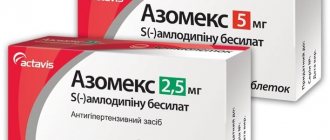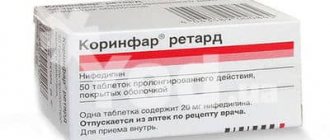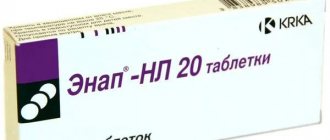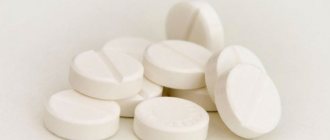Pharmacodynamics and pharmacokinetics
Lercanidipine is a typical calcium channel blocker that reduces the active transport of calcium ions through a semi-permeable membrane into cardiomyocytes of vascular smooth muscle cells. Under the influence of this substance, total peripheral vascular resistance and blood pressure . The hypotensive effect of taking the drug is quite long-lasting and lasts throughout the day. The medicine does not have a negative inotropic effect.
The substance is completely adsorbed from the gastrointestinal tract. The maximum concentration is observed one and a half to three hours after administration. The product is quickly distributed throughout all tissues and organs. The degree of binding to proteins in the blood is up to 98%. With hypoalbunemia , liver and kidney failure, the free fraction tends to increase. Repeated administration of the drug does not lead to its accumulation. Metabolized in the liver using the CYP3A4 , half of the drug taken is excreted through the kidneys in the urine. The half-life is from 7 to 10 hours.
Lercanidipine
Drug interactions
When used simultaneously with CYP3A4 inhibitors (including ketoconazole, intraconazole, erythromycin), drug interactions are possible (use combinations with caution).
When used together with CYP3A4 inducers (including antidepressants, rifampicin), the antihypertensive effect of lercanidipine may be reduced.
The hypotensive effect of lercanidipine may be enhanced by consuming grapefruit juice.
Ethanol may potentiate the action of lercanidipine.
When used simultaneously with metoprolol, the bioavailability of lercanidipine is reduced by 50%. This effect may also occur when used concomitantly with other beta-blockers, so dose adjustment of lercanidipine may be required to achieve a therapeutic effect with this combination.
Lercanidipine is metabolized with the participation of the CYP3A4 isoenzyme, therefore inhibitors and inducers of this isoenzyme, when used simultaneously, can affect the metabolism and excretion of lercanidipine. Concomitant use of lercanidipine with CYP3A4 inhibitors (ketoconazole, itraconazole, ritonavir, erythromycin, troleandomycin) is not recommended.
The simultaneous use of cyclosporine and lercanidipine is not recommended, because There is an increase in the concentration of both substances in the blood plasma.
Caution should be exercised when lercanidipine is used concomitantly with other CYP3A4 substrates (terfenadine, astemizole, class III antiarrhythmic drugs, e.g. amiodarone, quinidine).
When lercanidipine 20 mg is co-administered with midazolam, the bioavailability of lercanidipine in elderly patients may increase by approximately 40%.
Lercanidipine should be administered with caution concomitantly with inducers of CYP3A4, such as anticonvulsants (phenytoin, carbamazepine) and rifampicin, as the antihypertensive effect of the drug may be reduced. Regular blood pressure monitoring is necessary.
When lercanidipine was co-administered at a dose of 20 mg in patients chronically taking beta-methyldigoxin, no pharmacokinetic interaction was observed, while healthy volunteers treated with digoxin experienced an average 33% increase in digoxin Cmax after dosing of 20 mg. lercanidipine in the fasted state, with AUC and renal clearance changing slightly. Patients receiving digoxin and lercanidipine concomitantly should be monitored for signs of digoxin toxicity.
The simultaneous use of lercanidipine with cimetidine (up to 800 mg) does not cause significant changes in the concentration of lercanidipine in the blood plasma. At high doses of cimetidine, the bioavailability and antihypertensive effect of lercanidipine may be increased.
With simultaneous use of lercanidipine (20 mg) and simvastatin (40 mg), the AUC value for simvastatin increased by 56%, and the same value for its active metabolite - β-hydroxy acid - by 28%.
By taking drugs at different times of the day (lercanidipine in the morning, simvastatin in the evening) you can avoid unwanted interactions.
The antihypertensive effect may be enhanced by simultaneous administration of grapefruit juice and lercanidipine.
Ethanol may potentiate the antihypertensive effect of lercanidipine.
Contraindications
The substance is contraindicated:
- for chronic heart failure in the stage of decompensation;
- for aortic stenosis and unstable angina ;
- if less than a month ago the patient suffered a myocardial infarction ;
- with severe liver failure;
- if the CK reaches less than 10 ml per minute;
- with galactosemia ;
- patients with lactose intolerance, with malabsorption syndrome of galactose , glucose ;
- pregnant women;
- children and teenagers;
- when breastfeeding;
- patients with allergies to the components of the drug and other dihydropyridine derivatives.
Side effects
Side effects from taking Lercanidipine are quite rare.
May appear:
- peripheral edema , flushing of the face;
- palpitations, chest pain;
- angina pectoris , asthenia , headache , tachycardia ;
- myocardial infarction , dizziness , nausea;
- indigestion, vomiting, stomach pain;
- diarrhea , gum hyperplasia;
- increased activity of liver enzymes (reversible), decreased blood pressure ;
- skin rashes, myalgia , polyuria , drowsiness .
Lercanidipine, instructions for use (Method and dosage)
The tablets are taken orally. In the morning, on an empty stomach. Not earlier than a quarter of an hour before meals. It is not recommended to chew the medicine. Take the tablets with plenty of water.
On average, the daily dosage is 10 mg, but it can be doubled. The daily dose can be increased in the second week of treatment.
For mild to moderate liver and kidney diseases, it is better not to increase the dosage, but to take the minimum active dose of 10 mg.
Lercanidipine-SZ, 30 pcs., 10 mg, tablets
The drug should not be used simultaneously with inhibitors of CYP3A4 (liver cytochrome P450 isoenzyme), such as ketoconazole, itraconazole, erythromycin (increase the concentration of lercanidipine in the blood and lead to potentiation of the antihypertensive effect). The simultaneous use of lercanidipine with cyclosporine is contraindicated as this leads to an increase in the content of both substances in the blood plasma.
Lercanidipine should not be taken with grapefruit juice, as this leads to inhibition of lercanidipine metabolism and potentiation of the antihypertensive effect.
Caution must be exercised when taken concomitantly with drugs such as terfenadine, astemizole, quinidine and class III antiarrhythmic drugs (for example, amiodarone).
Concomitant use with anticonvulsants (for example, phenytoin, carbamazepine) and rifampicin may lead to a decrease in the plasma concentration of lercanidipine and, therefore, a decrease in the antihypertensive effect of lercanidipine.
In patients chronically taking digoxin, no pharmacokinetic interaction was observed with concomitant use of lercanidipine at a dose of 20 mg. However, in healthy volunteers taking digoxin, there was an average 33% increase in digoxin plasma Cmax after fasting oral administration of 20 mg lercanidipine, with little change in the AUC and renal clearance of digoxin. Patients receiving digoxin and lercanidipine concomitantly should be monitored for signs of digoxin toxicity.
When lercanidipine 20 mg is co-administered with midazolam, the bioavailability of lercanidipine in elderly patients may increase by approximately 40%.
Metoprolol reduces the bioavailability of lercanidipine by 50%, while the bioavailability of metoprolol remains unchanged. This effect may occur due to a decrease in hepatic blood flow, which is caused by beta-blockers, and may therefore also occur when used with other drugs in this group.
Cimetidine at a dose of 800 mg per day does not lead to significant changes in the concentration of lercanidipine in the blood plasma, however, special caution is required, since at higher doses of cimetidine the bioavailability of lercanidipine, and therefore its antihypertensive effect, may increase.
With simultaneous use of lercanidipine (20 mg) and simvastatin (40 mg), the AUC value for simvastatin increased by 56%, and for its active metabolite beta-hydroxy acid - by 28%. By taking medications at different times of the day (lercanidipine in the morning, simvastatin in the evening), unwanted interactions can be avoided.
When used simultaneously with fluoxetine (an inhibitor of CYP2D6 and CYP3A4 isoenzymes) in elderly patients, no clinically significant changes in the pharmacokinetics of lercanidipine were detected.
Taking lercanidipine simultaneously with warfarin does not affect the pharmacokinetics of the latter.
Lercanidipine can be used simultaneously with beta-blockers, diuretics, and angiotensin-converting enzyme (ACE) inhibitors.
Ethanol may enhance the antihypertensive effect of lercanidipine.
Interaction
Combination use of the drug with inhibitors of the CYP3A4 ( ketoconazole , erythromycin , itraconazole , ritonavir ) may weaken or increase the effect of the drug. Inducers of CYP3A4 (antidepressants, rifampicin ) reduce the antihypertensive effect of the drug. facilities.
When Lercanidipine is combined with grapefruit juice, its hypotensive effect is reduced.
Alcohol and ethanol containing drugs potentiate the effect of the drug.
This substance cannot be combined with cyclosporine , this leads to a significant increase in the plasma concentration of both substances.
The combined use of the drug with metoprolol and other beta-blockers leads to a decrease in the bioavailability of the drug.
The combination of Lercanidipine with midazolam at a dosage of 20 mg leads to an increase in the bioavailability of the drug in elderly patients.
When Lercanidipine is combined with digoxin, of digoxin increases . Careful monitoring of patients' condition is necessary.
Taking the drug in combination with 800 mg of cimetidine does not lead to changes in the pharmacokinetic parameters of the drug.
Simultaneous treatment with this substance and simvastatin is preferably carried out at different times of the day. Take lercanidipine in the morning and simvastatin before bed.
Lercanidipine-SZ 20 mg N30 (Northern Star)
The drug should not be used simultaneously with inhibitors of CYP3A4 (liver cytochrome P450 isoenzyme), such as ketoconazole, itraconazole, erythromycin (increase the concentration of lercanidipine in the blood and lead to potentiation of the antihypertensive effect). The simultaneous use of lercanidipine with cyclosporine is contraindicated as this leads to an increase in the content of both substances in the blood plasma. Lercanidipine should not be taken with grapefruit juice, as this leads to inhibition of lercanidipine metabolism and potentiation of the antihypertensive effect. Caution must be exercised when taken concomitantly with drugs such as terfenadine, astemizole, quinidine and class III antiarrhythmic drugs (for example, amiodarone). Concomitant use with anticonvulsants (for example, phenytoin, carbamazepine) and rifampicin may lead to a decrease in the plasma concentration of lercanidipine and, therefore, a decrease in the antihypertensive effect of lercanidipine. In patients chronically taking digoxin, no pharmacokinetic interaction was observed with concomitant use of lercanidipine at a dose of 20 mg. However, in healthy volunteers who took , there was an increase in the Cmax value of digoxin in blood plasma by an average of 33% after oral administration of 20 mg lercanidipine on an empty stomach, while the AUC and renal clearance of digoxin changed little. Patients receiving digoxin and lercanidipine concomitantly should be monitored for signs of digoxin toxicity. When lercanidipine 20 mg is co-administered with midazolam, the bioavailability of lercanidipine in elderly patients may increase by approximately 40%. Metoprolol reduces the bioavailability of lercanidipine by 50%, while the bioavailability of metoprolol remains unchanged. This effect may occur due to a decrease in hepatic blood flow, which is caused by beta-blockers, and may therefore also occur when used with other drugs in this group. Cimetidine at a dose of 800 mg per day does not lead to significant changes in the concentration of lercanidipine in the blood plasma, however, special caution is required, since at higher doses of cimetidine the bioavailability of lercanidipine, and therefore its antihypertensive effect, may increase. With simultaneous use of lercanidipine (20 mg) and simvastatin (40 mg), the AUC value for simvastatin increased by 56%, and for its active metabolite beta-hydroxy acid - by 28%. By taking medications at different times of the day (lercanidipine - in the morning, - in the evening), you can avoid unwanted interactions. When used simultaneously with fluoxetine (an inhibitor of CYP2D6 and CYP3A4 isoenzymes) in elderly patients, no clinically significant changes in the pharmacokinetics of lercanidipine were detected. Taking lercanidipine simultaneously with warfarin does not affect the pharmacokinetics of the latter. Lercanidipine can be used simultaneously with beta-blockers, diuretics, and angiotensin-converting enzyme (ACE) inhibitors. Ethanol may enhance the antihypertensive effect of lercanidipine.
Drugs containing (Lercanidipine analogues)
Level 4 ATC code matches:
Lacipil
Cordafen
Azomex
Nimodipine
Felodipin
Nifedipine
Farmadipin
Amlotop
Nimotop
Tenox
Nifecard HL
Cordipin
Felodip
Normodipine
Phenigidine
Norvask
Cordaflex
Lerkamen
Corinfar
Vero-Amlodipine
Analogues of lek. products: Zanidip-Recordati , Lercanidipine hydrochloride , Lernikor , Lerkamen 10 and 20 mg, Lercanorm , Coripren (multicomponent product), Enal L Combi (with enalapril ).
Instructions for use LERKAMEN 10
Since lercanidipine is metabolized by the CYP3A4 isoenzyme, inhibitors and inducers of the CYP3A4 isoenzyme taken together with the drug may affect the metabolism and elimination of lercanidipine.
The simultaneous administration of lercanidipine hydrochloride with inhibitors of the CYP3A4 isoenzyme (including ketoconazole, itraconazole, ritonavir, erythromycin, troleandomycin) should be avoided.
An interaction study with the strong CYP3A4 inhibitor ketoconazole showed that plasma concentrations of lercanidipine were markedly increased (15-fold increase in AUC and 8-fold increase in Cmax for the S-lercanidipine eutomer).
Cyclosporine and lercanidipine should not be co-administered. Increased plasma concentrations were observed for both lercanidipine and cyclosporine following coadministration. A study in young healthy volunteers showed that when cyclosporine was administered 3 hours after lercanidipine, the plasma concentration of lercanidipine was unchanged, whereas the AUC of cyclosporine increased by 27%. However, coadministration of lercanidipine hydrochloride with cyclosporine resulted in a 3-fold increase in lercanidipine plasma concentrations and a 21% increase in cyclosporine AUC.
When lercanidipine was administered orally at a dose of 20 mg to elderly volunteers together with midazolam, the absorption of lercanidipine increased (by approximately 40%) and the rate of absorption decreased (Tmax slowed down and was 3 hours instead of 1.75 hours). Midazolam concentrations did not change.
Caution should be exercised when using lercanidipine hydrochloride simultaneously with other substrates of the CYP3A4 isoenzyme (terfenadine, astemizole), antiarrhythmic drugs (amiodarone, quinidine).
Inducers of the CYP3A4 isoenzyme (anticonvulsants - phenytoin, carbamazepine) and rifampicin can reduce the concentration of lercanidipine in plasma, reducing the effectiveness of lercanidipine. Because the hypotensive effect may be reduced, blood pressure should be monitored more frequently.
When lercanidipine hydrochloride was administered concomitantly with metoprolol (which is metabolized primarily in the liver), the bioavailability of metoprolol did not change, while the bioavailability of lercanidipine was reduced by 50%. This effect is likely due to the reduction in hepatic blood flow caused by beta-blockers and may therefore also occur with other drugs in this class. Therefore, lercanidipine can be prescribed concomitantly with beta-blockers, but dosage adjustment may be required.
An interaction study with fluoxetine (an inhibitor of CYP2D6 and CYP3A4 isoenzymes), conducted on volunteers aged 65±7 years, indicates the absence of clinically significant changes in the pharmacokinetics of lercanidipine.
Co-administration of cimetidine 800 mg/day does not cause significant changes in plasma concentrations of lercanidipine, but caution is required at higher doses as the bioavailability and hypotensive effect of lercanidipine may be increased.
Co-administration of 20 mg lercanidipine to patients chronically taking β-methyldigoxin showed no pharmacokinetic interaction. In healthy volunteers using digoxin, digoxin Cmax increased by an average of 33% after taking 20 mg lercanidipine in the fasted state, while AUC and renal clearance were not significantly affected. Patients receiving digoxin concomitantly with lercanidipine should be closely monitored (frequent clinical monitoring) for digoxin toxicity.
When lercanidipine hydrochloride was administered repeatedly at a dose of 20 mg concomitantly with 40 mg simvastatin, the AUC value for lercanidipine changed little, while the AUC value for simvastatin increased by 56%, the AUC value for its active β-hydroxy acid metabolite increased by 28%. It is unlikely that such changes are clinically significant. It is recommended to use lercanidipine in the morning and simvastatin in the evening.
When 20 mg of lercanidipine was taken on an empty stomach concomitantly with warfarin, no changes in the pharmacokinetics of warfarin were observed in healthy volunteers.
Lercanidipine hydrochloride can be used simultaneously with diuretics and ACE inhibitors.
Lerkamen 10 should not be taken with grapefruit juice, since due to the increase in systemic bioavailability, the hypotensive effect of the drug also increases.
During therapy with Lerkamen 10, alcohol should be avoided, since ethanol may potentiate the effect of vasodilating antihypertensive drugs.
There were no cases of pharmaceutical incompatibility.





